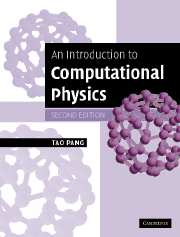Book contents
- Frontmatter
- Contents
- Preface to first edition
- Preface
- Acknowledgments
- 1 Introduction
- 2 Approximation of a function
- 3 Numerical calculus
- 4 Ordinary differential equations
- 5 Numerical methods for matrices
- 6 Spectral analysis
- 7 Partial differential equations
- 8 Molecular dynamics simulations
- 9 Modeling continuous systems
- 10 Monte Carlo simulations
- 11 Genetic algorithm and programming
- 12 Numerical renormalization
- References
- Index
Preface to first edition
Published online by Cambridge University Press: 05 June 2012
- Frontmatter
- Contents
- Preface to first edition
- Preface
- Acknowledgments
- 1 Introduction
- 2 Approximation of a function
- 3 Numerical calculus
- 4 Ordinary differential equations
- 5 Numerical methods for matrices
- 6 Spectral analysis
- 7 Partial differential equations
- 8 Molecular dynamics simulations
- 9 Modeling continuous systems
- 10 Monte Carlo simulations
- 11 Genetic algorithm and programming
- 12 Numerical renormalization
- References
- Index
Summary
The beauty of Nature is in its detail. If we are to understand different layers of scientific phenomena, tedious computations are inevitable. In the last half-century, computational approaches to many problems in science and engineering have clearly evolved into a new branch of science, computational science. With the increasing computing power of modern computers and the availability of new numerical techniques, scientists in different disciplines have started to unfold the mysteries of the so-called grand challenges, which are identified as scientific problems that will remain significant for years to come and may require teraflop computing power. These problems include, but are not limited to, global environmental modeling, virus vaccine design, and new electronic materials simulation.
Computational physics, in my view, is the foundation of computational science. It deals with basic computational problems in physics, which are closely related to the equations and computational problems in other scientific and engineering fields. For example, numerical schemes for Newton's equation can be implemented in the study of the dynamics of large molecules in chemistry and biology; algorithms for solving the Schrödinger equation are necessary in the study of electronic structures in materials science; the techniques used to solve the diffusion equation can be applied to air pollution control problems; and numerical simulations of hydrodynamic equations are needed in weather prediction and oceanic dynamics.
Important as computational physics is, it has not yet become a standard course in the curricula of many universities.
Information
- Type
- Chapter
- Information
- An Introduction to Computational Physics , pp. xi - xiiPublisher: Cambridge University PressPrint publication year: 2006
